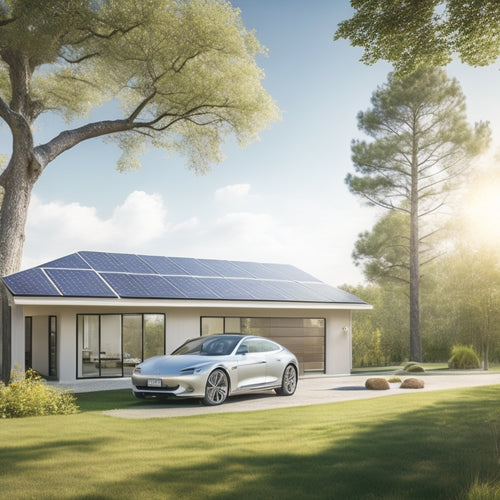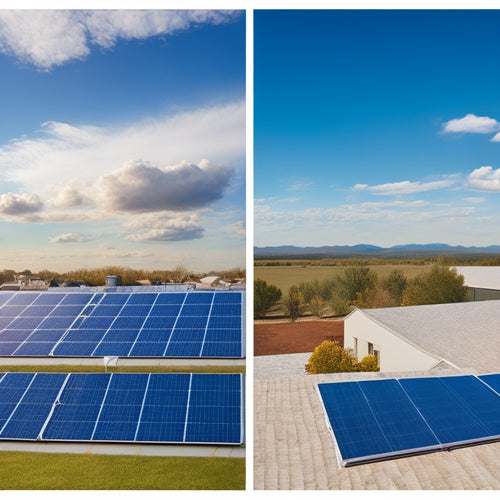
Small Home Green Energy System Installation Costs
Share
You're looking to install a small home green energy system, and you're wondering what it'll cost. Expect to pay between $15,000 and $30,000 or more, depending on the size and quality of the system, installation complexity, and local incentives. Factors like roof type, battery type, and inverter quality also influence costs. To get the most out of your investment, you'll want to assess your energy usage, roof space, and energy efficiency goals. Now that you have a rough estimate, take a closer look at the components that make up your total cost – and discover how to optimize your system for maximum savings.
Key Takeaways
• Average small home green energy system installation costs range from $15,000 to $30,000 or more, depending on system size and equipment quality.
• Governments offer incentives, such as tax credits, to offset a significant portion of the installation costs, making green energy more accessible.
• System size, equipment quality, and labor rates influence overall costs, which can be reduced with energy-efficient goals and property constraints in mind.
• Battery backup systems, inverters, and mounting/tracking systems add to the overall cost, with high-quality components ensuring peak energy efficiency.
• Federal and state incentives, such as the Solar Investment Tax Credit and residential renewable energy tax credits, can cover up to 30% of the total installation expense.
Average Cost of Solar Panels
When considering a home green energy system, you'll likely want to know that the average cost of solar panels ranges from $15,000 to $30,000 or more, depending on the system size and quality. This significant investment can seem overwhelming, but it's important to remember that solar panels are a vital step towards reducing your carbon footprint.
By harnessing the power of the sun, you'll be producing clean energy and decreasing your reliance on fossil fuels. In the long run, this energy efficiency will save you money on your utility bills and increase your property value. Plus, many governments offer incentives for homeowners who invest in renewable energy, so be sure to research those perks in your area.
While the upfront cost may seem steep, think of it as a long-term investment in the health of our planet. By going solar, you'll be doing your part to reduce greenhouse gas emissions and create a more sustainable future. So, take the first step towards a greener tomorrow – and a lower energy bill – by considering solar panels for your home.
System Size and Installation Costs
When determining a home green energy system size, you'll need to assess the ideal system size for your specific needs. This depends on factors such as your energy usage, available roof space, and local building codes.
The system cost will be influenced by the size you choose, as well as other factors like equipment quality, installation complexity, and local labor rates. By understanding these cost factors, you'll be able to make an informed decision about your system's size and installation.
System Size Options
As you consider installing a home green energy system, you'll need to determine the most efficient system size, which directly affects the overall installation costs and your return on investment. The system size you choose will impact how much energy you produce and how much you'll save on your utility bills.
When selecting a system size, consider your energy efficiency goals and the space constraints of your property. A larger system may provide more energy, but it may not be feasible if you have limited roof space or a small yard.
To determine the best system size, assess your energy usage and identify areas for improvement. Look for opportunities to increase energy efficiency, such as upgrading to energy-efficient appliances or adding insulation to your home. This will help you determine how much energy you need to produce and, subsequently, the ideal system size.
System Cost Factors
Several key factors greatly impact the overall cost of your home green energy system installation. Factors such as system size, installation complexity, and local labor costs all play a crucial role in determining the final price tag.
You might think, 'What's the big deal? It's just a few solar panels, right?' Not quite. The size of your system directly affects the number of panels, inverters, and other equipment needed, which in turn impacts the cost. A larger system means more materials, more labor, and a higher price tag.
Installation complexity is another vital factor to consider. A simple roof-mounted system will be cheaper than a complex, ground-mounted one. Local labor costs also play a significant role and can vary significantly depending on your location.
A savvy homeowner like you will want to take into account these factors to ensure you're getting the best value for your investment. By conducting a thorough cost analysis, you can optimize your energy efficiency and get the most out of your green energy system. After all, going green shouldn't break the bank!
Installation Cost Breakdown
Now that you've considered the factors affecting your home green energy system installation costs, let's break down the costs into their components, starting with system size and installation costs, which are often the largest expenses.
When it comes to system size, the bigger the system, the more expensive it gets. A larger system means more equipment, materials, and labor, which translates to higher costs. On the other hand, a smaller system may not provide enough energy to power your home, making it essential to find the right balance.
Here's a breakdown of the installation costs:
-
Labor costs: This includes the cost of hiring professionals to install the system, which can range from $2,000 to $5,000 or more, depending on the complexity of the installation.
-
Equipment costs: This includes the cost of the solar panels, inverters, and other equipment, which can range from $10,000 to $20,000 or more, depending on the quality and efficiency of the equipment.
-
Permitting and inspection costs: This includes the cost of obtaining necessary permits and undergoing inspections, which can range from $1,000 to $3,000 or more.
- Energy efficiency upgrades: This includes the cost of upgrading your home's energy efficiency, such as adding insulation or new windows, which can range from $2,000 to $5,000 or more.
Roof Type and Installation Fees
Your roof's type and size greatly influence the installation fees for your home green energy system. Steeper or more complex roofs require additional labor and equipment costs. The type of roof material also plays a significant role. Metal or tile roofs are more challenging to work with than asphalt shingles.
Installation timing is another important factor. Installations during peak season (summer or early fall) may incur higher fees due to high demand. The age of your roof is also a consideration. Older roofs may require more extensive repairs or replacements, adding to the overall cost.
The installation crew's experience and expertise impact the final bill. More experienced crews may potentially charge higher rates. Roof obstacles like skylights, vents, or chimneys can further complicate the installation process, driving up costs.
Lastly, be sure to inquire about the installation warranty offered by the installation company. This can provide peace of mind and protect your investment.
Battery Backup System Costs
As you consider the overall cost of your home green energy system, you'll need to factor in the additional expense of a battery backup system, which can add thousands of dollars to the total bill. This energy storage system allows you to store excess energy generated by your solar panels during the day, providing grid independence and a reliable source of power during outages or at night.
Here are some key components that affect the cost of a battery backup system:
-
Battery Type and Capacity: The type and capacity of batteries you choose will greatly impact the overall cost. Lithium-ion batteries, for instance, are more expensive than lead-acid batteries.
-
Inverter and Charger: A compatible inverter and charger are necessary to convert DC power from the batteries to AC power for your home.
-
Monitoring and Control Systems: A monitoring system helps you track your energy usage and storage levels, while a control system guarantees seamless shifts between grid and battery power.
- Installation and Labor Costs: The complexity of the installation, including wiring and electrical connections, will add to the overall cost.
Inverter Replacement Costs
Replacing a faulty inverter can be a costly endeavor, with the average inverter replacement cost ranging from $2,000 to $5,000 or more, depending on the type and capacity of the inverter, as well as the complexity of the replacement process. You might be wondering, 'Why is it so pricey?' Well, it's because a high-quality inverter is important for peak energy efficiency, and a replacement requires a significant investment.
The inverter lifespan typically ranges from 10 to 15 years, but with proper maintenance, it can last longer. However, when it fails, it's important to replace it promptly to avoid energy losses and system downtime. You don't want to compromise your energy efficiency, do you?
When selecting a replacement inverter, consider one that's compatible with your existing system and has a high efficiency rating. This will ensure you're maximizing your energy production while minimizing your costs.
Mounting and Tracking System Fees
When it comes to installing a home green energy system, you'll need to factor in the cost of a mounting and tracking system, which can range from $2,000 to $10,000 or more, depending on the complexity of the installation and the type of system you choose.
A good mounting system ensures your solar panels are securely fastened to your roof, providing the best energy output while withstanding harsh weather conditions. Here are some key aspects to take into account:
-
Ground Clearance: Make sure your mounting system provides sufficient clearance between the panels and your roof to allow for airflow and easy maintenance.
-
Structural Integrity: The system must be designed to support the weight of the panels and withstand wind, rain, and snow loads.
-
Adjustable Tilt: A tracking system that adjusts to the perfect angle for maximum energy absorption is essential.
- Durable Materials: High-quality materials like anodized aluminum and stainless steel ensure your system withstands the elements.
Permits and Inspection Fees
How much will you need to budget for permits and inspections, which can add up to $1,500 to $5,000 or more to your overall installation costs? It's important to factor in these expenses, as they're an unavoidable part of the green energy system installation process. Local regulations and government oversight require that your system meets specific standards, guaranteeing it's safe and efficient.
As you navigate the permit process, you'll need to obtain the necessary approvals from your local authorities. This can include electrical permits, building permits, and potentially, zoning permits. Be prepared to submit detailed plans and schematics, which may require the expertise of a licensed engineer or architect.
Inspection fees will also apply, as government agencies will need to verify that your system meets local building codes and safety standards. These inspections may occur at multiple stages of the installation process, adding to the overall cost.
Don't underestimate the importance of complying with local regulations – it's vital to ensure your system operates safely and efficiently. Budget accordingly, and you'll be well on your way to harnessing the power of green energy.
Solar Panel Maintenance Costs
As you finish the installation of your green energy system, you'll need to take into account the ongoing expenses associated with maintaining your solar panels to guarantee peak performance and prolong their lifespan. Regular maintenance is important to make sure your solar panels operate at their best energy efficiency.
Here are some maintenance tasks you should consider:
-
Panel cleaning: Dirt and debris can reduce your solar panels' energy output. Cleaning them regularly can boost their energy efficiency by up to 21%.
-
Inverter checks: Your inverter converts DC power from your solar panels to AC power for your home. Regular checks ensure it's functioning correctly and efficiently.
-
Bolt torque checks: Loose bolts can lead to electrical connections weakening, reducing your system's energy output. Regular checks prevent this from happening.
- Electrical connections inspections: Verifying that all electrical connections are secure and not corroded ensures your system operates safely and efficiently.
Federal and State Incentives
As you explore ways to reduce the cost of your home green energy system installation, you'll want to familiarize yourself with the various federal and state incentives available.
You can greatly offset your upfront costs by taking advantage of tax credits and rebate programs offered by the government.
Tax Credits Available
You can greatly reduce the upfront cost of your home green energy system installation by taking advantage of federal and state tax credits, which can cover up to 30% of the total expense. These green incentives can help offset the initial investment, making it more feasible to switch to renewable energy sources.
Here's a breakdown of the tax credits you can expect:
-
Federal Solar Investment Tax Credit (ITC): 26% of the total cost
-
Residential Renewable Energy Tax Credit: 26% of the total cost
-
State Tax Credits: Varying amounts depending on the state
- Utility Rebates: Additional incentives from your utility company
Rebate Programs Offered
Beyond tax credits, rebate programs offered at the federal and state levels can further reduce the upfront cost of your home green energy system installation. You'll be thrilled to know that government incentives are available to encourage the adoption of renewable energy.
For instance, the U.S. Department of Agriculture's Rural Energy for America Program provides grants and loan guarantees to rural businesses and agricultural producers who install renewable energy systems. Additionally, some states offer rebates for homeowners who invest in solar panels or wind turbines. These state-sponsored programs can offer substantial rebates, sometimes up to 50% of the total installation cost.
Utility partnerships are another avenue to explore. Many utility companies offer rebates or special rates for customers who generate their own renewable energy. For example, some utilities offer net metering programs, which allow you to sell excess energy back to the grid and offset your electricity bills.
Frequently Asked Questions
Can I Install a Small Home Green Energy System Myself?
"Hey, DIY enthusiast! While it's possible to install a small home green energy system yourself, be aware that DIY challenges and safety concerns abound - electrical shock, roof damage, and warranty voidance, oh my!"
How Long Does a Typical Installation Take to Complete?
"When you're ready to greenify your pad, you'll wonder how long the installation will take. Typically, a small home green energy system installation timeline spans 2-5 days, depending on the workforce planning and complexity of the job."
Do I Need to Upgrade My Electrical Panel for Solar?
When going solar, you'll need to assess your electrical capacity - if your panel's limitations can't handle the extra power, you'll likely need an upgrade to guarantee a safe, efficient connection.
Can I Add More Panels to My System in the Future?
"You're thinking ahead! Yes, you can add more panels in the future, thanks to system scalability. Designing for future expansion now will save you headaches (and cash) down the line - clever move!"
Will a Green Energy System Increase My Property Value?
When you invest in a green energy system, you'll not only reduce your carbon footprint but also give your property a boost, providing a resale advantage that'll make your home more attractive to eco-conscious buyers.
Related Posts
-

Why Invest in Solar Car Battery Chargers Online?
By investing in a solar car battery charger online, you're not only reducing your reliance on fossil fuels but also o...
-

What Role Do Unicycles Play in Urban Transport?
As you navigate through congested city streets, unicycles emerge as a viable solution, slashing carbon emissions by u...
-

Tracking Solar Panels Vs Fixed Panels Cost Savings
When considering solar panel options, you'll want to weigh the cost savings of tracking solar panels versus fixed pan...


